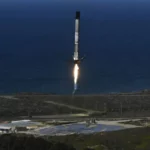By Aldgra Fredly
The United States Space Force will activate its first component command in the Indo–Pacific this week, aimed at deterring aggression in the region, as tensions with China and North Korea continue to rise.
The U.S. Indo–Pacific Command (INDOPACOM) said on Twitter that the new Space Force unit will be activated Tuesday, making INDOPACOM the first combatant command to host a Space Force unit since its inception in 2019.
The Space Command aims “to deter conflict and, if necessary, defeat aggression, deliver space combat power for the joint/combined force, and defend U.S. vital interests with allies and partners,” according to its website.
The component command will undergo mission analysis and planning over the next six months, Space Force Brig. Gen. Anthony Mastalir said Monday, adding that its activation signals the region’s importance to the United States.
“It’s a signal to anybody who would want to undermine either freedom of navigation, freedom of maneuver within a free-and-open Indo–Pacific, or anyone that would want to undermine the international rules-based order that has been the foundation for prosperity for all free nations that choose to participate,” Mastalir told reporters ahead of the activation.
The announcement came just days after North Korea fired a suspected intercontinental ballistic missile (ICBM) on Friday, North Korea’s longest-range missile designed to carry a nuclear warhead anywhere in the United States.
North Korean leader Kim Jong Un watched the ICBM launch with his daughter, in her first public appearance, and warned that his country will use nuclear weapons “with all-out confrontation” to counter threats from the United States, the state-run Korean Central News Agency reported.
North Korea contends that a U.S. military presence in the region is proof of the United States’ hostility toward the country. Pyongyang has also said its recent series of weapons launches were a response to what it called provocative military drills between the United States and South Korea.
China’s Threat
Space Force Gen. Bradley Saltzman, chief of space operations, earlier said the new component at INDOPACOM aims to strengthen U.S. space integration, citing China as the pacing threat, Air & Space Forces Magazine reported.
“We just think space is so critical now that we need a seat at that table,” Saltzman said in a meeting on May 19. “With China being the pacing threat, it was essential that we stand up the service component at INDOPACOM.”
“The biggest change is going to be the combatant commander will have a subordinate commander that they can task to effectively integrate space capabilities,” he added.
The Pentagon, in its annual report to Congress published in November 2021, highlighted China’s space and counterspace capabilities.
“The PRC [People’s Republic of China] continues to develop counterspace capabilities—including direct ascent, co-orbital, electronic warfare, and directed energy capabilities—that can contest or deny an adversary’s access to and operations in the space domain during a crisis or conflict,” the report reads.
One operational space technology in China’s arsenal is a ground-based anti-satellite (ASAT) missile, according to the report. In January 2007, China fired an anti-satellite missile against one of its inactive weather satellites, drawing international concern.
“China probably intends to pursue additional ASAT weapons capable of destroying satellites up to geosynchronous Earth orbit,” the report reads.
Mimi Nguyen Ly and Frank Fang contributed to this report.






